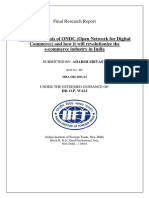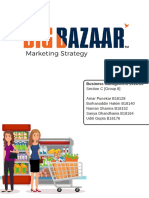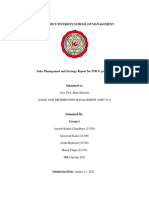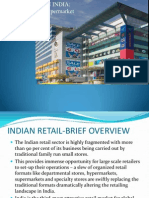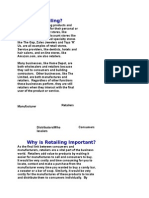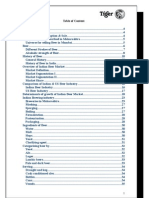Grocery Retailers in Pakistan
Grocery Retailers in Pakistan
Uploaded by
t2yangCopyright:
Available Formats
Grocery Retailers in Pakistan
Grocery Retailers in Pakistan
Uploaded by
t2yangOriginal Description:
Copyright
Available Formats
Share this document
Did you find this document useful?
Is this content inappropriate?
Copyright:
Available Formats
Grocery Retailers in Pakistan
Grocery Retailers in Pakistan
Uploaded by
t2yangCopyright:
Available Formats
GROCERY RETAILERS IN PAKISTAN
Euromonitor International April 2013
GROCERY RETAILERS IN PAKISTAN
Passport
LIST OF CONTENTS AND TABLES
Headlines ..................................................................................................................................... 1 Trends .......................................................................................................................................... 1 Traditional Vs Modern .................................................................................................................. 3 Competitive Landscape ................................................................................................................ 3 Prospects ..................................................................................................................................... 4 Channel Formats .......................................................................................................................... 5 Chart 1 Chart 2 Chart 3 Chart 4 Chart 5 Chart 6 Chart 7 Table 1 Table 2 Table 3 Table 4 Table 5 Table 6 Table 7 Table 8 Table 9 Table 10 Table 11 Table 12 Modern Grocery Retailers: Shell Select in Islamabad .................................. 5 Modern Grocery Retailers: A Tuk Shop Attock Petroleum in Islamabad .................................................................................................... 6 Modern Grocery Retailers: Esajee in Islamabad .......................................... 7 Traditional Grocery Retailers: Shams in Islamabad ..................................... 8 Traditional Grocery Retailers: Gourmet in Lahore ........................................ 9 Traditional Grocery Retailers: United Bakery in Islamabad ........................ 10 Traditional Grocery Retailers: Fruit and vegetable stall in Islamabad......... 11 Sales in Grocery Retailers by Channel: Value 2007-2012 ......................... 12 Grocery Retailers Outlets by Channel: Units 2007-2012 ............................ 13 Sales in Grocery Retailers by Channel: % Value Growth 2007-2012 ......... 13 Grocery Retailers Outlets by Channel: % Unit Growth 2007-2012 ............. 13 Grocery Retailers Company Shares: % Value 2008-2012 ......................... 14 Grocery Retailers Brand Shares: % Value 2009-2012 ............................... 14 Grocery Retailers Brand Shares: Outlets 2009-2012 ................................. 14 Grocery Retailers Brand Shares: Selling Space 2009-2012....................... 15 Forecast Sales in Grocery Retailers by Channel: Value 2012-2017 .......... 15 Forecast Grocery Retailers Outlets by Channel: Units 2012-2017 ............. 16 Forecast Sales in Grocery Retailers by Channel: % Value Growth 2012-2017 .................................................................................................. 16 Forecast Grocery Retailers Outlets by Channel: % Unit Growth 20122017 ........................................................................................................... 16
Channel Data ............................................................................................................................. 12
Euromonitor International
GROCERY RETAILERS IN PAKISTAN
Passport
GROCERY RETAILERS IN PAKISTAN
HEADLINES
Grocery retailers current value sales grow by 11% in 2012 to reach PKR1.9 trillion Traditional grocery retailers experiences lower value sales growth compared to the modern grocery channel The total number of grocery retailers outlets grow by 1% in 2012 to reach 469,320 Utility Store Corp of Pakistan was the market leader among grocery retailers with 4% market share in terms of value. Grocery retailers is set to decline by a constant value CAGR of 1% over the forecast period
TRENDS
Trends and changed in grocery retailers in 2012 were in line with the ongoing changes in retailing over the review period with no significant new changes introduced to alter dynamics. Traditional grocery retailers experienced slower growth of 10% compared to modern grocery retailers which increased by 18%. Modern grocery retailers is growing from a comparatively small base in terms of value sales but is at the forefront in terms of visibility and popularity amongst consumers. In line with changing lifestyles and demands of an urbanising population, consumers are going for one-stop solutions, lured by better prices, wider range of products, better, more professional service and shopping convenience at modern grocery retailers making them less dependent on neighbourhood grocery retailers. This also means that instead of shopping for necessary items on a daily/weekly basis, consumers are shifting towards buying their grocery needs on a monthly basis. Other grocery retailers was the biggest channel in current value sales terms in 2012, with 76% share. Led by the wide network of government-owned Utility Store Corps Utility Store, these retailers serve the local population through discount pricing and easy access to a large variety of products. Present in large cities, small towns and villages, these retailers cover a wide range of the population and are attractive places to shop from for a large segment of the population. As the face of the government in retailing, expansion in the number of outlets and use as a tool to provide relief from high inflation were the major activities occurring in this channel in 2012. Hypermarkets was the fastest growing channel in 2012 due to its small base. Current value sales grew by 75% in 2012, mainly due to the opening of a new (second) outlet in a high street mall (Dolmen Mall) in Karachi. Karachi is the largest city in Pakistan and also its business hub tapping into this area is an important step forward for hypermarkets. Hyperstar is the currently the only player in hypermarkets and is planning on opening a third outlet in Karachi in the latter half of 2012. Supermarkets was also one of the top performing channels amongst grocery retailers in 2012. Current value sales grew by 14% in 2012 which is above the average for grocery retailers and outlets grew by 3% which is much higher than 1% for grocery retailers as a whole. Rising popularity of this channel amongst consumers in urban centres led to more of them frequenting supermarkets for their regular grocery needs. More outlets provided greater coverage of urban centres, making it easier for consumers to opt to shop at supermarkets instead of their neighbourhood small grocery stores.
Euromonitor International
GROCERY RETAILERS IN PAKISTAN
Passport
The share of groceries in supermarkets declined steadily over the review period, falling from 76% in 2005 to 73% in 2012. In the case of hypermarkets, the share of groceries fell from 68% to 67% from 2009 to 2012. This indicates that these modern grocery retailers are paying more attention to non-grocery items by giving them more shelf-space this is caused by the higher margins often associated with these items and the strategy of these retailers to provide greater product variety to consumers. Another reason for this trend can be the profile of the consumers visiting supermarkets and hypermarkets urban middle to upper class shoppers are increasingly spending more on non-essential grocery items as incomes and lifestyles improve. Discounters was not present in Pakistan in 2012. There was a growing trend towards convenience in grocery retailing in Pakistan in 2012 as convenience retailing is an upcoming modern retailing channel. There is little consumer awareness or demand for more convenience stores as consumers are attuned to the traditional form of grocery retailing, but current sales are growing at a substantial pace and the trend is likely to catch on as urban consumers will appreciate the services that convenience stores has to offer. The unique selling point of forecourt retailers is that its operating hours and the association with petrol pumps and CNG stations. Consumers are spending more and more time waiting in lines at CNG stations and petrol pumps due to the frequent load shedding of CNG, especially in the winter season. Forecourt retailers witnessed an increase of 14% in current value sales in 2012. Domestic retailers completely dominated grocery retailers with only a few exceptions such as Hyperstar in hypermarkets. With the uncertain investment climate, not many foreign retailers have entered or are operating in Pakistani grocery retailers and growth and sales are almost completely driven by domestic retailers. Convenience stores grew by 18% in current value terms, which is much slower than the rapidly growing hypermarkets but marginally faster than the growth rate of supermarkets at 14%. This can be attributed to the more widespread coverage of convenience stores and the value consumers place on extended store timings. Independent small grocers also competes through location and relationship with customers proving to be its anchoring force. Its key strength is its longstanding presence and the convenience of location which is a major factor in a time of fuel shortages and high fuel prices, which make transportation an expensive commodity. Independent small grocers grew by 13% in current value terms in 2012. In 2012, the largest part of food/drink/tobacco specialists was accounted for food specialist retailers. This is because food is a daily necessity while consumption of drink and tobacco is limited to smaller population segments. Additionally, drink/tobacco specialists are decreasing in popularity, as these products are stocked by general grocery retailers with a much wider presence and even current specialists are moving towards expanding their product range to stay in business. Food/drink/tobacco specialists grew at a strong pace of 16% in current value terms in 2012 in response to growing population and demand for better quality food among Pakistans urban population. New outlets of successful chains such as Rahat Bakers, Gourmet Foods and Shezan indicated the consumers demand for quality and standardised products. Other grocery retailers include kiosks, market stalls and street vendors with a primary focus on selling food, drink and tobacco. In addition to this, other grocery retailers also includes Utility Store operated by Utility Store Corp of Pakistan, a government-run entity. This channel also includes health food stores, confectioners, newsagents, food and drink souvenir stores and regional speciality stores. Other grocery retailers increased by 9% in 2012 in current
Euromonitor International
GROCERY RETAILERS IN PAKISTAN
Passport
value terms, slower growth than posted in 2011 due to tough economic conditions for the lower strata of the society which form the main consumers in this channel. Other grocery retailers also faced strong competition from modern retailing channels. Internet retailing of grocery products was negligible in Pakistan in 2012, with most emerging internet retailing websites focusing on non-grocery items such as electronics and apparel.
TRADITIONAL VS MODERN
Traditional grocery retailers continued to dominate grocery retailing in Pakistan. This is because Pakistan is still a developing country and a large proportion of its population lives in rural areas where the reach of modern grocery retailing has not yet extended. Even in urban areas, traditional grocery retailing has strong roots and deep linkages with society. However, the value share of modern grocery retailers is on the rise due to gradual acceptance of modern retailing among Pakistani consumers, mainly in the middle and upper class of urban populations. In particular, hypermarkets and convenience stores are rapidly gaining acceptance and value share in urban and suburban areas. Traditional grocery retailers remains an important channel in Pakistan because it is deeply rooted in the social and economic systems of society. From the credit lines extended by independent small grocers to local neighbourhood communities to the omnipresence of Utility Store outlets across the country, the traditional channels are very much alive and dominant in the system. Modern retailing appeals to a particular segment of society due to their lifestyle and income groups, and it is rapidly gaining acceptability. The value share of traditional grocery retailers declined over the review period. This is because many Pakistani consumers switched to modern grocery retailers in search of greater convenience such as longer opening hours, better service, including clearly labelled prices, as well as a wider range of products and higher product quality, specifically food which was kept fresh through the use of refrigeration and imported premium brands. Realising the potential of modern grocery retailing, many supermarkets and hypermarkets are expanding or have plans to expand into Pakistans suburban areas. There are no specific government measures in Pakistan aimed at promoting either type of grocery retailing channel over the other. Traditional grocery retailers continued to compete on low prices and personal relationships with customers. This channel usually chooses strategic locations such as neighbourhood centres and busy markets in order to capture local customers. There is also some level of support seen in the form of trade unions that attempt to protect the businesses from any aggressive new entrants. Given that many traditional grocery retailers are small family-run businesses, they may not have specific strategies in place to compete with modern grocery retailers. For many traditional grocery retailers in Pakistan, it is very much business as usual with no thought-out strategies in the face of the threat of modern grocery retailing formats.
COMPETITIVE LANDSCAPE
Utility Store Corp of Pakistan led grocery retailers during 2012 with a value share of 4%. Utility Store Corp operated 6,012 outlets in Pakistan during 2012, an increase of 312 outlets from the previous year. The wide spread of its outlets across Pakistan makes it convenient for consumers to easily access the companys outlets. Utility Store Corp witnessed the highest increase in value share in grocery retailing in 2012. This was due to the sharp increase (6%) in the number of outlets and the strategy to open mega stores in select places which has also helped boost sales. In tough economic times
Euromonitor International
GROCERY RETAILERS IN PAKISTAN
Passport
with high inflation, the widespread network and the discount pricing that these retailers offer is a welcome sight for consumers. There were no mergers and acquisitions in 2012. Different grocery retailers leverage on different strengths in order to attract customers. Many traditional independent small grocers have established good relationships and a high level of trust with their customers, especially those operating in rural areas and small towns. On the other hand, modern grocery retailers focus more on product variety and the high quality of their goods as well as more efficient customer service such as transparent pricing with clear price label displays, electronic cash registers and the choice of either cash or credit card payment. Moreover, large grocery retailers are able to offer their products at lower prices and frequent discount promotions as they operate on a much larger scale. Both modern grocery retailers and traditional grocery retailers in Pakistan have different strengths in terms of regional coverage. Supermarkets and hypermarkets focus on major cities, where the population concentration is high and the population is relatively affluent in order to maximise sales and profits. However, these large retailers have yet to expand into Pakistans less affluent areas. Convenience stores are mainly located in cities, suburbs and town centres, where they provide extended opening hours and modern retailing facilities in order to meet the growing demand for convenience shopping. Traditional small grocers benefit from the widespread presence of these types of outlets throughout the country. Domestic retailers increased in value sales more than international retailers during 2012 due to better knowledge of consumer tastes and the cultural and the business environment in Pakistan. Additionally, they have a widespread network of outlets and strong personal relationships with consumers. Modern and traditional grocery channels in Pakistan appeal to different target audiences. Modern grocery retailers offer a greater variety of products but at above-average prices, while also offering convenience, transparent transactions using electronic cash registers and a better quality customer service, all of which are important to middle and upper-middle income consumers. Traditional grocery retailers, on the other hand, appeal to lower middle-income consumers, who account for 15% of the total population, and for whom price, convenience and location are the most important factors. There were no key new entrants in grocery retailers in 2012.
PROSPECTS
Grocery retailers in Pakistan is expected to decline by a constant value CAGR of 1% over the forecast period. The main reason for the negative growth is the high level of inflation that leaves the otherwise impressive current value growth to be insignificant in comparison. Modern grocery retailers is predicted to grow by a constant value CAGR of 4%, while traditional grocery retailers is estimated to shrink by a constant value CAGR of 1% over the forecast period. As urbanisation in Pakistan is likely to continue, modern grocery retailers will continue to enjoy high growth. Other grocery retailers will continue to grow and will remain dominant in retailing in Pakistan, particularly in small towns and rural areas. However, due to the rise of modern retailing and increasing urbanisation, this channel is expected to decline by a constant value CAGR of 2%. Hypermarkets is projected to be the fastest growing retailing channel in constant value terms, with a CAGR of 14%. This is due to several factors. Hypermarkets attracts consumers by offering a wide range of products including non-grocery merchandise. Product variety and convenience are important draws for customers. Secondly, the rapid pace of urbanisation in Pakistan is driving the expansion of hypermarkets such as Carrefour and the Metro Groups
Euromonitor International
GROCERY RETAILERS IN PAKISTAN
Passport
Real chain. Many of these new outlets are located in out-of-town sites or as the anchor stores in new shopping centres. Convenience is expected to gain currency in grocery retailers in Pakistan as modern retailing outlets become more prevalent. Some customers may switch from independent small grocers to modern retailing channels for the various benefits on offer such as higher quality products, transparent pricing, and reliable customer service and extended opening hours. Riding on the wave of the growing popularity of modern grocery retailers, both convenience stores and forecourt retailers will enjoy steady growth. Furthermore, this growth is expected to be faster than the growth expected in independent small grocers. The growth of small grocery retailers formats is expected to be slower than that of hypermarkets and supermarkets. Food/drink/tobacco specialists is expected to post strong growth, increasing by a constant value CAGR of 4%. In particular, chained food specialists such as Gourmet Foods and Shezan Confectionaries are likely to open more outlets in Pakistans cities in order to cater to the growing demand coming from the increasing population. As consumers in Pakistans cities acquire more sophisticated tastes and become more affluent, demand for fresh bread and confectionery is also expected to grow. Other grocery retailers is expected to experience a fall in sales, declining at a constant value CAGR of 2%. This is despite the stellar performance of Utility Store, as kiosks, market stalls and street vendors, which comprise the bulk of other grocery retailers, are likely to lose sales to modern grocery retailers, which offers a larger variety of fresher products. Internet retailing will continue to remain negligible through to 2017.
CHANNEL FORMATS
Chart 1 Modern Grocery Retailers: Shell Select in Islamabad
Euromonitor International
GROCERY RETAILERS IN PAKISTAN
Passport
Source:
Euromonitor International
Chart 2
Modern Grocery Retailers: A Tuk Shop Attock Petroleum in Islamabad
Euromonitor International
GROCERY RETAILERS IN PAKISTAN
Passport
Source:
Euromonitor International
Chart 3
Modern Grocery Retailers: Esajee in Islamabad
Euromonitor International
GROCERY RETAILERS IN PAKISTAN
Passport
Source:
Euromonitor International
Chart 4
Traditional Grocery Retailers: Shams in Islamabad
Euromonitor International
GROCERY RETAILERS IN PAKISTAN
Passport
Source:
Euromonitor International
Chart 5
Traditional Grocery Retailers: Gourmet in Lahore
Euromonitor International
GROCERY RETAILERS IN PAKISTAN
Passport
10
Source:
Euromonitor International
Chart 6
Traditional Grocery Retailers: United Bakery in Islamabad
Euromonitor International
GROCERY RETAILERS IN PAKISTAN
Passport
11
Source:
Euromonitor International
Chart 7
Traditional Grocery Retailers: Fruit and vegetable stall in Islamabad
Euromonitor International
GROCERY RETAILERS IN PAKISTAN
Passport
12
Source:
Euromonitor International
CHANNEL DATA
Table 1 Sales in Grocery Retailers by Channel: Value 2007-2012
PKR billion, retail value rsp excl sales tax 2007 Modern Grocery Retailers - Convenience Stores - Discounters - Forecourt Retailers -- Chained Forecourt Retailers -- Independent Forecourt Retailers - Hypermarkets - Supermarkets Traditional Grocery Retailers - Food/Drink/Tobacco Specialists - Independent Small Grocers - Other Grocery Retailers Grocery Retailers
Source:
2008 68.0 32.3 7.8 7.8 27.9 1,328.8 18.6 165.3 1,145.0 1,396.8
2009 86.0 42.3 8.7 8.7 2.0 32.9 1,388.5 25.4 191.1 1,172.0 1,474.4
2010 103.8 52.8 9.4 9.4 3.0 38.5 1,443.2 31.7 210.3 1,201.3 1,547.1
2011 124.0 64.4 10.8 10.8 4.0 44.8 1,634.1 38.0 238.6 1,357.4 1,758.1
2012 146.5 76.1 12.4 12.4 7.0 51.0 1,797.3 43.9 269.4 1,484.0 1,943.8
54.1 24.4 6.8 6.8 22.9 1,256.4 14.5 139.8 1,102.1 1,310.5
Euromonitor International from official statistics, trade associations, trade press, company research, trade interviews, trade sources
Euromonitor International
GROCERY RETAILERS IN PAKISTAN
Passport
13
Table 2 outlets
Grocery Retailers Outlets by Channel: Units 2007-2012
2007 Modern Grocery Retailers - Convenience Stores - Discounters - Forecourt Retailers -- Chained Forecourt Retailers -- Independent Forecourt Retailers - Hypermarkets - Supermarkets Traditional Grocery Retailers - Food/Drink/Tobacco Specialists - Independent Small Grocers - Other Grocery Retailers Grocery Retailers
Source:
2008 4,316 3,865 313 313 138 442,684 20,896 375,142 46,646 447,000
2009 4,558 4,102 316 316 1 139 450,613 20,954 380,214 49,445 455,171
2010 4,766 4,302 321 321 1 142 456,940 21,064 383,214 52,662 461,706
2011 4,883 4,410 325 325 2 146 462,232 21,169 384,714 56,349 467,115
2012 5,003 4,520 330 330 2 151 464,317 21,264 386,014 57,039 469,320
4,012 3,568 309 309 135 435,227 20,586 370,214 44,427 439,239
Euromonitor International from official statistics, trade associations, trade press, company research, trade interviews, trade sources
Table 3
Sales in Grocery Retailers by Channel: % Value Growth 2007-2012
% current value growth, retail value rsp excl sales tax 2011/12 Modern Grocery Retailers - Convenience Stores - Discounters - Forecourt Retailers -- Chained Forecourt Retailers -- Independent Forecourt Retailers - Hypermarkets - Supermarkets Traditional Grocery Retailers - Food/Drink/Tobacco Specialists - Independent Small Grocers - Other Grocery Retailers Grocery Retailers
Source:
2007-12 CAGR 22.0 25.5 12.7 12.7 17.4 7.4 24.8 14.0 6.1 8.2
2007/12 Total 170.7 211.6 82.0 82.0 122.7 43.1 203.0 92.7 34.7 48.3
18.1 18.3 14.3 14.3 75.0 13.8 10.0 15.5 12.9 9.3 10.6
Euromonitor International from official statistics, trade associations, trade press, company research, trade interviews, trade sources
Table 4 % unit growth
Grocery Retailers Outlets by Channel: % Unit Growth 2007-2012
2011/12 Modern Grocery Retailers 2.5
2007-12 CAGR 4.5
2007/12 Total 24.7
Euromonitor International
GROCERY RETAILERS IN PAKISTAN
Passport
14
- Convenience Stores - Discounters - Forecourt Retailers -- Chained Forecourt Retailers -- Independent Forecourt Retailers - Hypermarkets - Supermarkets Traditional Grocery Retailers - Food/Drink/Tobacco Specialists - Independent Small Grocers - Other Grocery Retailers Grocery Retailers
Source:
2.5 1.5 1.5 0.0 3.4 0.5 0.4 0.3 1.2 0.5
4.8 1.3 1.3 2.3 1.3 0.7 0.8 5.1 1.3
26.7 6.8 6.8 11.9 6.7 3.3 4.3 28.4 6.8
Euromonitor International from official statistics, trade associations, trade press, company research, trade interviews, trade sources
Table 5
Grocery Retailers Company Shares: % Value 2008-2012
% retail value rsp excl sales tax Company Utility Store Corp of Pakistan Carrefour MAF Hypermarkets Pakistan (Pvt) Ltd PSO Outlets Ltd Shell Pakistan Ltd Chevron Pakistan Ltd Others Total
Source:
2008 3.4 -
2009 3.5 0.1
2010 3.6 0.2
2011 3.4 0.2
2012 3.5 0.4
0.3 0.2 0.1 96.1 100.0
0.3 0.2 0.1 95.8 100.0
0.3 0.2 0.1 95.7 100.0
0.3 0.2 0.1 95.8 100.0
0.3 0.2 0.1 95.5 100.0
Euromonitor International from official statistics, trade associations, trade press, company research, trade interviews, trade sources
Table 6
Grocery Retailers Brand Shares: % Value 2009-2012
% retail value rsp excl sales tax Brand Company Utility Store Hyperstar Utility Store Corp of Pakistan Carrefour MAF Hypermarkets Pakistan (Pvt) Ltd PSO Outlets Ltd Shell Pakistan Ltd Chevron Pakistan Ltd
2009 3.5 0.1
2010 3.6 0.2
2011 3.4 0.2
2012 3.5 0.4
PSO Outlets Shell Caltex Others Total
Source:
0.3 0.2 0.1 95.8 100.0
0.3 0.2 0.1 95.7 100.0
0.3 0.2 0.1 95.8 100.0
0.3 0.2 0.1 95.5 100.0
Euromonitor International from official statistics, trade associations, trade press, company research, trade interviews, trade sources
Table 7 sites/outlets Brand
Grocery Retailers Brand Shares: Outlets 2009-2012
Company
2009
2010
2011
2012
Euromonitor International
GROCERY RETAILERS IN PAKISTAN
Passport
15
Utility Store PSO Outlets Shell Caltex Hyperstar
Utility Store Corp of Pakistan PSO Outlets Ltd Shell Pakistan Ltd Chevron Pakistan Ltd Carrefour MAF Hypermarkets Pakistan (Pvt) Ltd
5,550 177 67 33 1
5,650 179 68 32 1
5,700 182 68 31 2
6,012 185 70 32 2
Others Total
Source:
449,343 455,171
455,776 461,706
461,132 467,115
463,019 469,320
Euromonitor International from official statistics, trade associations, trade press, company research, trade interviews, trade sources
Table 8
Grocery Retailers Brand Shares: Selling Space 2009-2012
surface area '000 sq m Brand Utility Store PSO Outlets Hyperstar
Company Utility Store Corp of Pakistan PSO Outlets Ltd Carrefour MAF Hypermarkets Pakistan (Pvt) Ltd Shell Pakistan Ltd Chevron Pakistan Ltd
2009 2,100.0 30.3 9.0
2010 2,140.0 30.5 9.0
2011 2,160.0 31.0 18.0
2012 2,268.0 31.5 18.0
Shell Caltex Others Total
Source:
13.5 4.7 40,027.6 42,185.1
13.8 4.5 41,986.9 44,184.7
13.8 4.4 44,110.0 46,337.2
14.0 4.5 44,964.5 47,300.5
Euromonitor International from official statistics, trade associations, trade press, company research, trade interviews, trade sources
Table 9
Forecast Sales in Grocery Retailers by Channel: Value 2012-2017
PKR billion, retail value rsp excl sales tax 2012 Modern Grocery Retailers - Convenience Stores - Discounters - Forecourt Retailers -- Chained Forecourt Retailers -- Independent Forecourt Retailers - Hypermarkets - Supermarkets Traditional Grocery Retailers - Food/Drink/Tobacco Specialists - Independent Small Grocers - Other Grocery Retailers Grocery Retailers 146.5 76.1 12.4 12.4 7.0 51.0 1,797.3 43.9 269.4 1,484.0 1,943.8 2013 147.2 77.6 12.8 12.8 4.9 51.8 1,750.2 44.9 267.7 1,437.6 1,897.4 2014 153.3 79.7 13.3 13.3 6.8 53.4 1,721.8 46.3 268.3 1,407.2 1,875.1 2015 160.6 82.0 13.9 13.9 9.1 55.5 1,701.5 48.0 267.7 1,385.7 1,862.0 2016 168.9 84.8 14.4 14.4 11.6 58.1 1,695.7 50.3 270.3 1,375.2 1,864.6 2017 175.9 87.3 13.9 13.9 13.6 61.0 1,691.1 52.7 273.5 1,364.9 1,867.0
Euromonitor International
GROCERY RETAILERS IN PAKISTAN
Passport
16
Source:
Euromonitor International from trade associations, trade press, company research, trade interviews, trade sources
Table 10 outlets
Forecast Grocery Retailers Outlets by Channel: Units 2012-2017
2012 Modern Grocery Retailers - Convenience Stores - Discounters - Forecourt Retailers -- Chained Forecourt Retailers -- Independent Forecourt Retailers - Hypermarkets - Supermarkets Traditional Grocery Retailers - Food/Drink/Tobacco Specialists - Independent Small Grocers - Other Grocery Retailers Grocery Retailers
Source:
2013 5,109 4,610 339 339 3 157 465,933 21,349 387,014 57,570 471,042
2014 5,205 4,691 346 346 4 164 467,602 21,445 387,964 58,193 472,807
2015 5,293 4,761 355 355 5 172 469,315 21,531 388,864 58,920 474,608
2016 5,356 4,809 361 361 6 180 470,856 21,639 389,642 59,575 476,212
2017 5,394 4,833 365 365 7 189 472,133 21,736 390,226 60,171 477,527
5,003 4,520 330 330 2 151 464,317 21,264 386,014 57,039 469,320
Euromonitor International from trade associations, trade press, company research, trade interviews, trade sources
Table 11
Forecast Sales in Grocery Retailers by Channel: % Value Growth 2012-2017
% current value growth, retail value rsp excl sales tax 2012-17 CAGR Modern Grocery Retailers - Convenience Stores - Discounters - Forecourt Retailers -- Chained Forecourt Retailers -- Independent Forecourt Retailers - Hypermarkets - Supermarkets Traditional Grocery Retailers - Food/Drink/Tobacco Specialists - Independent Small Grocers - Other Grocery Retailers Grocery Retailers
Source:
2012/17 TOTAL 20.1 14.7 12.5 12.5 94.9 19.8 -5.9 19.8 1.5 -8.0 -3.9
3.7 2.8 2.4 2.4 14.3 3.7 -1.2 3.7 0.3 -1.7 -0.8
Euromonitor International from trade associations, trade press, company research, trade interviews, trade sources
Table 12 % unit growth
Forecast Grocery Retailers Outlets by Channel: % Unit Growth 2012-2017
2016/17
2012-17 CAGR
2012/17 Total
Euromonitor International
GROCERY RETAILERS IN PAKISTAN
Passport
17
Modern Grocery Retailers - Convenience Stores - Discounters - Forecourt Retailers -- Chained Forecourt Retailers -- Independent Forecourt Retailers - Hypermarkets - Supermarkets Traditional Grocery Retailers - Food/Drink/Tobacco Specialists - Independent Small Grocers - Other Grocery Retailers Grocery Retailers
Source:
0.7 0.5 1.1 1.1 16.7 5.0 0.3 0.4 0.1 1.0 0.3
1.5 1.3 2.0 2.0 28.5 4.6 0.3 0.4 0.2 1.1 0.3
7.8 6.9 10.6 10.6 250.0 25.2 1.7 2.2 1.1 5.5 1.7
Euromonitor International from trade associations, trade press, company research, trade interviews, trade sources
Euromonitor International
You might also like
- Chinsu. Germany - ReportDocument65 pagesChinsu. Germany - ReportHải YếnNo ratings yet
- 5 C InventoDocument2 pages5 C InventoAashna DuggalNo ratings yet
- Pakistan Retail Census 2Document1 pagePakistan Retail Census 2syedqamarNo ratings yet
- Operations at Retail Industry BIG BAZARDocument104 pagesOperations at Retail Industry BIG BAZARArpita Bera0% (1)
- India Baby Care Market Opportunity AnalysisDocument0 pagesIndia Baby Care Market Opportunity AnalysisNeeraj ChawlaNo ratings yet
- IB1816104 EntrepreneurshipDocument22 pagesIB1816104 EntrepreneurshipNavdhaNo ratings yet
- Evolution of Retail Industry in India PDFDocument2 pagesEvolution of Retail Industry in India PDFJennieNo ratings yet
- Supply Chain Management at Varun Beverages Pepsi: Presented by Ravi KhandelwalDocument19 pagesSupply Chain Management at Varun Beverages Pepsi: Presented by Ravi Khandelwalravi khandelwalNo ratings yet
- Sr. No. Topic Page Number: IndexDocument53 pagesSr. No. Topic Page Number: IndexArman Shaikh100% (1)
- Shoppers Stop - Catchment Analysis and Customer Satisfaction Study of Shoppers StopDocument20 pagesShoppers Stop - Catchment Analysis and Customer Satisfaction Study of Shoppers StopRidhima SharmaNo ratings yet
- New Trend Indian Retail SectorDocument13 pagesNew Trend Indian Retail SectorGourav AnandNo ratings yet
- Retailing Sector of Pakistan - Wholesale, General, Modern TradeDocument7 pagesRetailing Sector of Pakistan - Wholesale, General, Modern TradeFaizan Ahmad Khan100% (1)
- Asean Grocery Retail 18jul2017Document123 pagesAsean Grocery Retail 18jul2017ytee50% (2)
- Assginment Product and Brand Management: Submitted To: Submitted byDocument42 pagesAssginment Product and Brand Management: Submitted To: Submitted byZil ShahNo ratings yet
- Final Globus - ProjectDocument72 pagesFinal Globus - Projectravi_sms001No ratings yet
- Reliance FreshDocument23 pagesReliance FreshKrishna Murari SinghNo ratings yet
- Structure: Vegetable MarketDocument3 pagesStructure: Vegetable MarketMadhuri GuptaNo ratings yet
- Industry Awareness (IA) Indian Institute of Management, IndoreDocument25 pagesIndustry Awareness (IA) Indian Institute of Management, IndoreSaurabh KumarNo ratings yet
- Analysis of Retail IndustryDocument11 pagesAnalysis of Retail IndustryVipul ThapaNo ratings yet
- Supply Chain Management of RECKEIIT BENKSEIERDocument6 pagesSupply Chain Management of RECKEIIT BENKSEIERFuhad AhmedNo ratings yet
- Global Logistics AssignmentDocument3 pagesGlobal Logistics AssignmentSara KiranNo ratings yet
- Retail Industry in IndiaDocument23 pagesRetail Industry in IndiaKhushboo AgrawalNo ratings yet
- Market Retail Edelweiss 10.01.18Document310 pagesMarket Retail Edelweiss 10.01.18lakshayNo ratings yet
- Rural FMCG - Final ReportDocument19 pagesRural FMCG - Final Reportthe record breakerNo ratings yet
- 4 Ps of CromaDocument9 pages4 Ps of CromaRoshni Patel100% (1)
- Introduction To Retailing... A Need of MarketDocument33 pagesIntroduction To Retailing... A Need of MarketKhemchand DevnaniNo ratings yet
- Hypercity Reseach ProjectDocument122 pagesHypercity Reseach ProjectAnamika SinghNo ratings yet
- India - The Base of Pyramid Distribution Challenge-IfMRDocument63 pagesIndia - The Base of Pyramid Distribution Challenge-IfMRarunimdrNo ratings yet
- Candy and Chocolate India (CCI)Document12 pagesCandy and Chocolate India (CCI)Nikhil JoyNo ratings yet
- DSCM Cia 1Document62 pagesDSCM Cia 1Albert Davis 2027916No ratings yet
- A Report On FMCG Industry in IndiaDocument7 pagesA Report On FMCG Industry in IndiabalajinsbNo ratings yet
- Adarsh Srivastava - 2C - Final Year ProjectDocument44 pagesAdarsh Srivastava - 2C - Final Year ProjectAdarsh SrivastavaNo ratings yet
- Bajaj Electricals Fans Group9 Part1Document26 pagesBajaj Electricals Fans Group9 Part1Aayushi Singh100% (1)
- 02.ashok Kumar (Retail Management)Document14 pages02.ashok Kumar (Retail Management)samrat_akr6519No ratings yet
- Big Bazaar Marketing StrategyDocument30 pagesBig Bazaar Marketing StrategyBurhanuddin Hakim100% (1)
- .... Credit-Risk-Management@ CiplaDocument77 pages.... Credit-Risk-Management@ Ciplamoula nawazNo ratings yet
- Anudeep Gill: Big TeamDocument29 pagesAnudeep Gill: Big TeamKaran VohraNo ratings yet
- Chapter - IDocument24 pagesChapter - IStartechnico TechnocratsNo ratings yet
- MTM Cia 3Document24 pagesMTM Cia 3AKHIL THOMAS 1827503No ratings yet
- Swot Analysis of Reliance FreshDocument2 pagesSwot Analysis of Reliance FreshYounus ahmedNo ratings yet
- Project Report On Digiworld at MumbaiDocument77 pagesProject Report On Digiworld at Mumbaisantosh888888No ratings yet
- FMCG Company ReportDocument23 pagesFMCG Company ReportGautam NakraniNo ratings yet
- VIP BagsDocument32 pagesVIP Bagsakshay0% (1)
- Major Factors Responsible For The Growth of Organised Retailing in IndiaDocument5 pagesMajor Factors Responsible For The Growth of Organised Retailing in IndiajeganrajrajNo ratings yet
- FMCG Group 1Document52 pagesFMCG Group 121324jesikaNo ratings yet
- Big Bazaar Vs Reliance MartDocument5 pagesBig Bazaar Vs Reliance MartMalvika Mehra100% (1)
- Bajaj Auto SM - PPTDocument46 pagesBajaj Auto SM - PPTWaibhav KrishnaNo ratings yet
- HUL Case StudyDocument40 pagesHUL Case StudyAditya JhaNo ratings yet
- Aditya Birla Fashion - Motilal Oswal - AR AnalysisDocument24 pagesAditya Birla Fashion - Motilal Oswal - AR Analysisvipul sharmaNo ratings yet
- A Critical Analysis of ITC Distribution Channel MarketingDocument9 pagesA Critical Analysis of ITC Distribution Channel MarketingNishkarshNo ratings yet
- MaricoDocument28 pagesMaricoSiddhantSethia100% (1)
- Comparative Analysis of Oyo & Ginger Grp-9 PDFDocument31 pagesComparative Analysis of Oyo & Ginger Grp-9 PDFadityakr2410100% (1)
- Reliance Fresh StrategyDocument2 pagesReliance Fresh StrategyBIKASH SAHOONo ratings yet
- Case 6 - Retailing in IndiaDocument22 pagesCase 6 - Retailing in IndiaSanjay NayakNo ratings yet
- Retail Project ReportDocument69 pagesRetail Project ReportRaman100% (1)
- Bigbazaar Catchment Area Analysis, Pattom, TrivandrumDocument75 pagesBigbazaar Catchment Area Analysis, Pattom, Trivandrumlijuvj80% (5)
- Grocery Store PDFDocument36 pagesGrocery Store PDFARJUN HALDARNo ratings yet
- Fast Food in Vietnam Jan2014Document22 pagesFast Food in Vietnam Jan2014ANDYLAU1234No ratings yet
- What Is Retailing?Document7 pagesWhat Is Retailing?munish747No ratings yet
- Supermarkets in The PhilippinesDocument8 pagesSupermarkets in The PhilippinesRalph Julius VillanuevaNo ratings yet
- Consumer Lifestyles in PakistanDocument76 pagesConsumer Lifestyles in Pakistant2yangNo ratings yet
- Laundry Care PakistanDocument10 pagesLaundry Care Pakistant2yangNo ratings yet
- Colgate Palmolive Exit Laundry DetergentsDocument2 pagesColgate Palmolive Exit Laundry Detergentst2yangNo ratings yet
- Entrepreneurs Born or Made?Document24 pagesEntrepreneurs Born or Made?t2yang100% (2)
- Integrated Marketing Communications and BrandingDocument20 pagesIntegrated Marketing Communications and Brandingt2yang50% (2)
- Conflict in Family BusinessDocument23 pagesConflict in Family Businesst2yang100% (1)
- Soap Bar QualitiesDocument3 pagesSoap Bar Qualitiest2yangNo ratings yet
- Marketing of Beer in MumbaiDocument112 pagesMarketing of Beer in Mumbaishailesh Maurya100% (2)
- Regional Sales Manager TradeDocument1 pageRegional Sales Manager Tradet2yangNo ratings yet
- Working Capital ManagementDocument25 pagesWorking Capital ManagementSazib SarkarNo ratings yet
- DA 185 4A2 - Exporter Registration - External FormDocument6 pagesDA 185 4A2 - Exporter Registration - External FormNthabiseng Dinah MaidiNo ratings yet
- 3.0 PV, FV, NPV, Irr & MirrDocument8 pages3.0 PV, FV, NPV, Irr & MirrIshrat Jahan DiaNo ratings yet
- K KRPW 7 NFFF V5 LMW NDocument15 pagesK KRPW 7 NFFF V5 LMW NKiran KumarNo ratings yet
- Statement of Cash FlowDocument45 pagesStatement of Cash FlowJay Bianca Abera Alistado100% (1)
- Fixed Exchange Rate System - Under This System, All Countries Were Required To Set A SpecificDocument3 pagesFixed Exchange Rate System - Under This System, All Countries Were Required To Set A SpecificRemar22No ratings yet
- Unity Small Finance Bank LimitedDocument1 pageUnity Small Finance Bank Limitedprakash kushwahaNo ratings yet
- Ex 6 Duo - 2021 Open-Macroeconomics Basic Concepts: Part 1: Multple ChoicesDocument6 pagesEx 6 Duo - 2021 Open-Macroeconomics Basic Concepts: Part 1: Multple ChoicesTuyền Lý Thị LamNo ratings yet
- Assessment of Tax Collection Problems (Acase Study On Sokoru WoredaDocument49 pagesAssessment of Tax Collection Problems (Acase Study On Sokoru WoredaAbdurehman B Hasen100% (2)
- Guide To The Markets AsiaDocument87 pagesGuide To The Markets AsiaJavier Arles Lopez AstaizaNo ratings yet
- ChopperDocument1 pageChopperKhushi JainNo ratings yet
- De Torres John Carlyle - IEDocument5 pagesDe Torres John Carlyle - IECamille ArellanoNo ratings yet
- Cash Flow DiagramDocument39 pagesCash Flow DiagramJunior Noel100% (1)
- Argumentative EssayDocument5 pagesArgumentative Essayapi-549110612No ratings yet
- Statement of Cash Flow - Ias 7Document5 pagesStatement of Cash Flow - Ias 7Benjamin JohnNo ratings yet
- Drivers of GlobalisationDocument37 pagesDrivers of GlobalisationDinesh Gannerlla100% (1)
- Bitcoin-Money-Or-Financial-Investment - Article FDocument4 pagesBitcoin-Money-Or-Financial-Investment - Article FJosef Galileo SibalaNo ratings yet
- Foreign TradeDocument6 pagesForeign TradeMehak joshiNo ratings yet
- Working Capital ManagementDocument21 pagesWorking Capital ManagementRonak PanchalNo ratings yet
- International Business (Slides)Document21 pagesInternational Business (Slides)Alavi Ashiq SiamNo ratings yet
- Economics StatisticsDocument4 pagesEconomics StatisticsPalak NikamNo ratings yet
- Government AccountingDocument93 pagesGovernment Accountingpilonia.donitarosebsa1993No ratings yet
- CASH MathDocument3 pagesCASH MathNuzat Nawar TofaNo ratings yet
- CSEP SC Paper-3Document53 pagesCSEP SC Paper-3Manikanta ReddyNo ratings yet
- Chapter 9 FinmarDocument5 pagesChapter 9 FinmarJuan JohnNo ratings yet
- G2E Weekly Meeting 10Document2 pagesG2E Weekly Meeting 10RUANGLADDA LIMPONGSAWATNo ratings yet
- Student Declaration: I, Mohit Yadav Student of MBA IV From DIMS, Meerut Here by Declares That The ProjectDocument104 pagesStudent Declaration: I, Mohit Yadav Student of MBA IV From DIMS, Meerut Here by Declares That The ProjectSumbal JameelNo ratings yet
- Inbt211 ReviewerDocument13 pagesInbt211 ReviewerSydney Miles MahinayNo ratings yet
- Department StoreDocument11 pagesDepartment StoreInder NegiNo ratings yet































